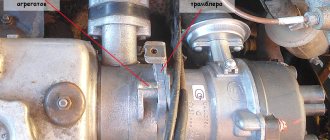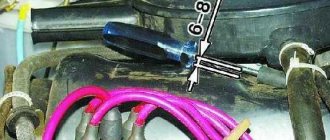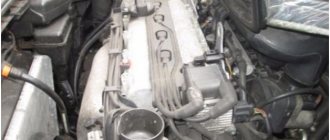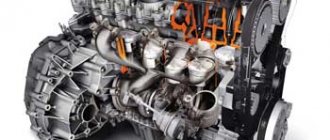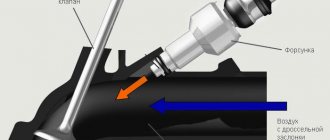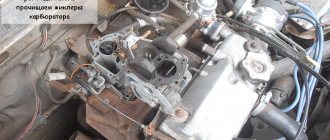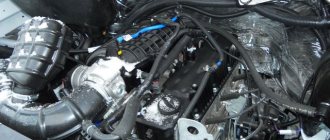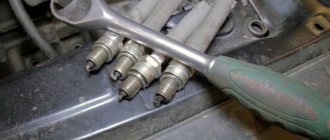Any self-respecting driver will begin to find out the reasons why an injection engine does not develop full power, as soon as he notices a drop in the prescribed characteristics.
Even if you don’t really need all the power of the car at the moment, slow acceleration or dullness when driving are very annoying. In addition, such signs clearly indicate that not everything is in order with the engine. And even a beginner can understand that it is impossible to skip diagnostics - this can lead to serious consequences that will cost more than eliminating the problem in its initial stage. And most drivers treat the car more like a friend than an object. And people care about the health of their loved ones on an instinctive level.
The reasons why an injection engine does not develop full power can be general - common to all types of engines - and individual, which are typical exclusively for injectors.
Can happen to anyone
With any engine organization, problems with a decrease in power can be caused by universal factors. Namely:
- In the forefront, as always, is bad fuel. If power is lost almost immediately after leaving the gas station, consider that the cause has been found. Additional symptoms may include difficulty starting the engine, carbon deposits on the spark plug contact group, and a red coating on their skirts. These signs will help determine the cause if gasoline was added to a good level and did not show itself immediately;
- A clogged air filter also prevents the engine from developing the required power - the mixture is supplied with insufficient air, as a result of which it does not burn completely;
- The filter is clogged, but this is a fuel filter. In this case, the mixture entering the engine is lean, insufficient to gain speed;
- Worn out or dirty spark plugs. However, even beginners know this reason and check them first;
- Problems with the catalyst - its contamination or final wear. The reason is disappointing, since the catalyst does not cost a penny, and it is not always possible to clean it. For this reason, some car owners simply remove it from the exhaust system;
- The next assumption is no less stressful - there is a malfunction in the fuel system in the form of a fuel pump failure. Less catastrophic would be the depressurization of one of the pipes: here the spare parts are cheaper and the work is simpler;
- And finally, the saddest thing is the malfunction of the unit itself. Moreover, not everyone can determine which node. This could be wear on the piston rings, a violation of the gaps between the valves, a drop in compression, etc. In any case, deep study cannot be avoided.
Points 1 to 4 are easily detected and just as easily eliminated. With more complex ones, most people turn to the service.
The main reasons for the reduction in engine power
Crankshaft position sensor malfunction
There are situations when the DCPV untimely sends a control command to supply the air-fuel mixture. As a result, the power of the power unit drops before our eyes. The main cause of the failure is the shift of the toothed star relative to the pulley and the delamination of the damper. In such a situation, it is necessary to carefully inspect the damper and replace it.
Increasing (decreasing) the gap between the spark plug electrodes
During operation, due to strong temperature effects, the distance between the electrodes of the spark plug may decrease or increase. To exclude or confirm your suspicion, you need to check the size of the gaps using a round feeler gauge. If the distance is less or more than acceptable, you need to make an adjustment by bending the side of the electrode or replace the spark plug. As for the optimal spark gap distance, it can be different (depending on the type of spark plug) - 0.7-1.0 mm.
The appearance of carbon deposits on the spark plugs is another clear sign of a problem.
If the engine does not pull well, you need to unscrew all the spark plugs one by one and inspect them. If obvious carbon deposits appear on the electrodes, the device must be cleaned using a brush with metal bristles. It is important not only to clean the spark plugs or replace them, but also to find out the cause of this phenomenon.
Failure of spark plugs
A decrease in engine power may be caused by product failure. In this case, it is necessary to check the performance of the spark plug on a special stand. If the suspicions are confirmed, then the only way out is to replace the set or one spark plug.
There is no gasoline in the tank
You can diagnose the problem using the fuel level indicator. If it is faulty or there is a suspicion that it is “inadequate,” then the presence of fuel can be determined by removing the fuel pump.
Fuel filter contamination, water freezing in the system, pinched fuel wire, fuel pump failure
All these malfunctions can be safely classified into one category, because they all have the same symptoms - the starter cranks the engine, but there is no smell of fuel from the exhaust pipe. If the car has a carburetor, then the reason must be sought in the float chamber. Most likely, fuel is not supplied to it. In the case of an injector, it is easier to check the presence of fuel in the ramp by pressing a special spool (installed at the end of the ramp).
To correct the problem, you need to warm up the engine thoroughly and bleed the power system with a tire pump. After this, all system pipes, hoses and the fuel pump itself are changed.
Fuel pump produces too little pressure
This problem can only be determined by special measurements (taken directly at the outlet of the fuel pump). After this, the quality of operation of the fuel pump filter is checked.
The solution is to clean the fuel pump filter, replace it (if repair is not possible) or install a new fuel pump.
Poor contact quality in the circuit
Poor contact quality in the circuit that powers the fuel pump or failure of its relay. The first thing you need to do to check is to make sure the quality of the “ground” on the car and measure the resistance using a multimeter. If the resistance level is really too high, then the only way out is to clean the contact groups, crimp the terminals well, or install a relay (if the old one is faulty).
Failure of injectors or malfunction in the supply system
If there is a suspicion of failure of these elements, it is necessary to check the resistance of the windings using a multimeter for a break or an interturn short circuit. If the cause of the problem is a malfunction of the computer, then such a check can only be carried out at a service station.
There are several ways to eliminate a decrease in engine power for this reason (depending on the depth of the problem) - install a new ECU, clean all injectors, ensure good contact in the electrical circuit, and so on.
DPKV failure
Failure of the crankshaft position sensor or damage to its circuit. In such a situation, the Check Engine light comes on. The first thing to do is to inspect the integrity of the DCP itself, make sure that the gap between the ring gear and the sensor is normal (it should be about one millimeter). The normal resistance of the sensor coil is about 600-700 Ohms.
To solve the problem, it is enough to restore normal contact in the electrical circuit and install a new sensor (if the old one turns out to be faulty).
DTOZH is out of order
The DTOZH - the sensor that controls the temperature of the coolant - has failed. Symptoms of the malfunction are as follows: the engine malfunction lamp comes on. If there is a break, the system’s electric fan begins to rotate continuously. In addition, it is necessary to check the serviceability of the sensor itself.
Injection problems
If the car has been checked for general problems, but the cause of the loss of power has not been identified, we move on to the individual characteristics of the system.
The injectors have automatic detection of the ignition timing. To set it correctly, you need to use the readings of many sensors. If one of them does not work, the onboard “brains” consider the situation to be an emergency and set a low angle, which leads to a drop in power.
You will have to check:
- oxygen concentration sensors;
- throttle position sensor;
- coolant temperature sensor;
- phase sensor
Not only the sensors themselves require ringing, but also the circuits into which they are included - broken wiring or oxidation of the terminals lead to the same consequences as failure of the device.
- If the sensors are operational, you will have to check the ECU: purely computer failures are quite possible;
- Dirty or damaged injectors. Usually this is reported by the all-knowing Check. An ohmmeter is used to check the windings on the injectors and, naturally, the circuits leading to/from them;
- The controller may also be faulty - this is also indicated in most cases by a lit Check. The fastest and most reliable way to check is to replace the part with a new working one. Naturally, you also need to check the wires with the contacts on it. Sadly, the injector itself may also fail.
Loss of power in some cases can also have very primitive reasons. For example, incorrectly adjusted gas pedal travel. In this case, the throttle valve does not open completely, which is why the engine does not get the opportunity to work at full capacity.
If you have not been able to independently determine the reasons why the injection engine does not develop full power, do not put off visiting a car service center for too long. Especially if you have to travel outside your hometown: even if you don’t break down on the way, it will take quite a long time to get to your destination due to existing problems with the engine.
Causes
There may be several reasons for the lack of proper speed gain:
- There are problems with the air supply;
- The ignition has failed;
- Fuel system malfunctions have occurred;
- There were problems with the exhaust system.
Fuel system problems are common in gasoline engines. They are the most common. Therefore, you should start with checking it.
Fuel system
If problems arise when accelerating the car, start checking by inspecting the fuel system.
- Most often, the engine stops gaining momentum because the fuel pump fails. At first, this may have a slight effect, sometimes unnoticed. Over time, as the pump wears out, the speed and power will begin to drop, and the acceleration dynamics will decrease.
- If the fuel pump is partially damaged, it still partially performs its functions, but is no longer capable of delivering the same volumes of fuel. This results in fuel starvation and power loss.
- The best solution to a problem with the pump is to replace it. It is better to trust repairs to specialists.
Ignition
If the ignition fails, you will have to conduct a comprehensive check of all system components that may cause a drop in engine power and speed.
What to check
Peculiarities
Checking timing marks
If the marks are installed incorrectly, fuel will not be injected in a timely manner, and the correct frequency of spark supply will be disrupted.
You will have to check all the sensors that take part in the operation of the ignition system. Pay special attention to the crankshaft and camshaft position sensors. A regular test allows you to quickly determine whether the sensors are really to blame
If the belt has been in use on your vehicle for a long time, it may be at the end of its service life. Or it was installed incorrectly when replacing it. After all, it is enough to make a mistake by one tooth, and the performance of the car will be impaired, the car will not be able to accelerate properly
In some cases, they do not allow the car to start at all if there is a malfunction, but sometimes they lead to a noticeable drop in power. Remove them, check their condition, clean them, measure the distance between the electrodes. If they fail, simply replace them with new ones.
To finally verify the presence or absence of problems in the ignition system, it is recommended to conduct more detailed diagnostics.
Diagnostics
We suggest you familiarize yourself with several steps aimed at diagnosing the condition of the ignition system. This may help determine why the engine is not revving up.
- Make sure that the electronic control unit is performing its functions. First of all, turn on the ignition and listen to whether the fuel pump starts working.
- Measure the pressure in the fuel line. If the readings fall within 2.5-3.0 kg/cm3, then everything is fine.
- If the measurement readings are normal, check the BitStop parameter using scan tools while cranking the crankshaft. If the parameter is indicated “no”, then the ECU receives the command to create a spark at the plugs and works well.
- Using a high-voltage spark gap, you can check for the presence of a spark. After all, it’s not uncommon for worn-out, dirty spark plugs to be to blame.
Air supply
It is not uncommon for engine thrust to deteriorate due to a disruption in the normal air supply to create the air-fuel mixture.
If there is more air, the mixture will be lean because the amount of oxygen will exceed the amount of fuel. Hence the drop in power and decrease in traction.
The easiest way to solve an air supply problem is to replace the air filter. In order to prevent and prevent problems from occurring, this element should be changed twice a year.
Checking the mass air flow sensor
If the engine speed increases, but the speed does not increase, there are several possible explanations for this phenomenon:
- The pressure in the fuel system is too low;
- The operation of the mass air flow sensor is disrupted. The sensor most often returns to its previous performance after cleaning. If it doesn't help, replace it;
- The air filter is clogged. It is better to replace it;
- The nozzle is clogged. This is mainly due to the low quality of the fuel you fill your car with.

